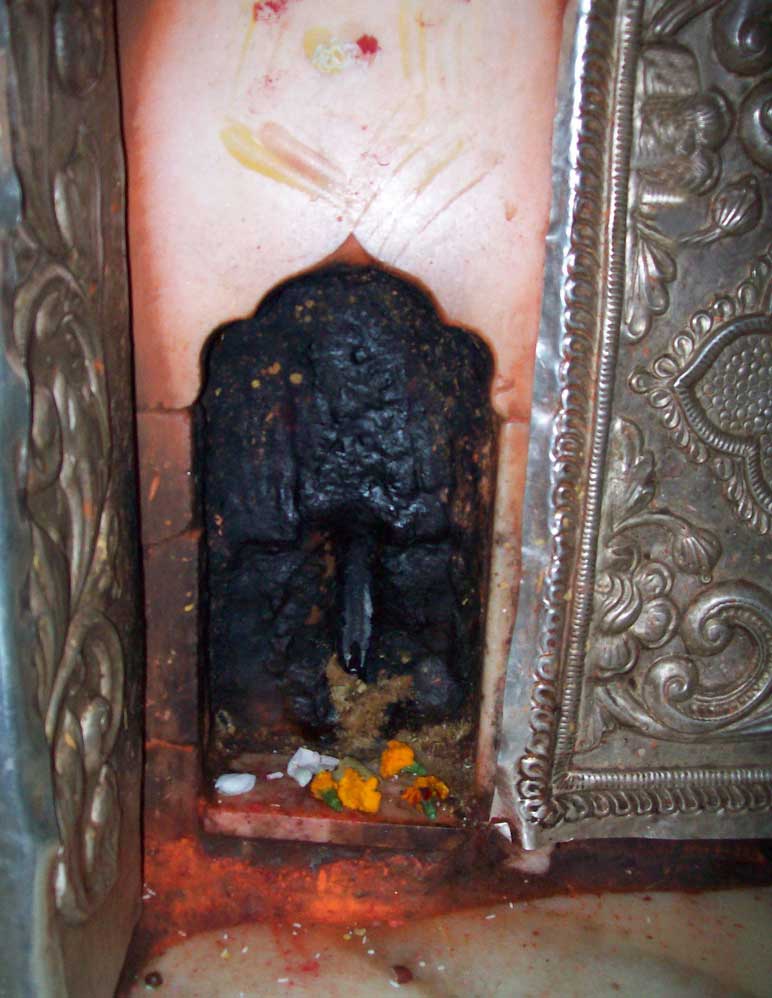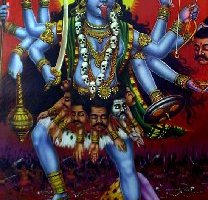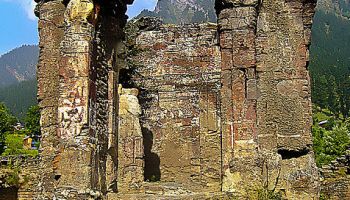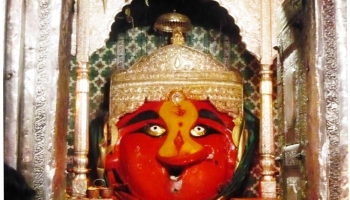5th SEPTEMBER 2015 MAA JWALAMUKHI_KANGRA DHARMASHALA HIMACHAL PRADESH
Flaming Devi Jwalamukhi Shakti Peeta
-
More images for jwalamukhi devi
MAA JWALA DEVI MANDIR - YouTube
www.youtube.com/watch?v=_9xqkdnLUnU
Oct 22, 2012 - Uploaded by Manoj Mehta
Maa Jwala Devi, Jwala Ji, Jwalamukhi is the most famous Shakti Peetha where it is said that the "Tongue" of ...Devi‘s Head fell in Vaishnav Devi near Kangra, Himachal Pradesh.
There are versions that it the place where The Devi’s Tongue fell.
Here The Goddess called Jwalamukhi, Flamng Face,is with a Flaming Mouth.
“Jwalayam Vishnavi devi, Gaya Mangalya gourika //’ Ashtadasa Stotram Ad Shankaracharya.
The Emanating Flames are worshiped as the manifestations of the different forms of Goddess Jwala Maa.
The Nine flames are,
Maha Kali,
Annapurna,
Chandi,
Hinglaj,
Vindhyavasini,
Maha Saraswati,
Maa Ambika and
The Fires continue to burn without any Fuel being added.
Mughal Emperor Akbar visited this Temple to verify this.
How To Reach.
By Air: Gaggal airport, also known as Dharamsala airport, inKangra valley is about 40 km away from Jwalamukhi. This airport connects domestic flights to Delhi. International travelers have to connect through Delhi Airport, which is about 450 km away from Dharamsala. Delhi Airport is connected to all major cities in India and abroad.
By Road: Regular bus services ply regularly from several cities to Jwalamukhi and Kangra. Private luxury buses are also available from Delhi and other north Indian cities.
By Rail: Nearest railway station is Kangra Mandir but all trains do not stop here. The nearest railhead is Pathankot, about 85 km away from Dharamsala. Pathankot is well connected to all major cities in India.
Temple Timings.
Timings – Opening & Closing:
Monday – Friday: 6.00 AM – 7.00 PM ,
Saturday: 6.00 AM – 7.00 PM ,
Sunday: 6.00 AM – 7.00 PM ,
Public Holidays: 6.00 AM – 7.00 PM
The Legends:
One is known to all, that of Daksha Yaga and Sati immolating herself.
According to another legend, the Goddess appeared in a dream to a Brahmin in faraway South India, and directed him to proceed to the hills of Kangra in the shadow of the Dhauladhars and search for small tongues of flame leaping from the ground. The Brahmin, it is said responded discovered the sacred spot and in due course of time, erected a temple. Some people believe that Jwalamukhi represents the flaming mouth of Jalandhara, the demon whom Lord Shiva crushed to death by placing on him a huge mass of mountains.
Dhyanu Bhagat is well known devotee of Maa Durga. It is him who spread Devi Mata’s name. He lived at the time of the Mughal Emperor Akbar. Dhyanu Bhagat was going to Jwalaji with a group of pilgrims. Akbar summoned him to his court to inquire into the nature of their Goddess. Dhyanu Bhagat told him She is all powerful and answers the prayers of Her devotees.
To test Her power Akbar cut off the head of Dhyanu’s horse ordering him to have the Goddess put it back. Dhyanu went to Maa Jwalaji and prayed day and night to no avail. Out of desperation he cut of his own head and offered it to Devi Maa. She then appeared to him riding a lion. She reconnected both his head and that of the horse. Devi Maa also offered Dhyanu Bhagat a boon. He requested that it should not be so difficult for pigrams to show their devotion. Mata said that in the future if someone offered a coconut she would accept it as if they had offered their own head. To this day people continue to offer coconuts to the Goddess in Her temples all over the world. After the knowing that the head of horse is reconnected, Akbar the great Mughal Emperor visited the temple. The water course which today drips into a tank in the temple premises is said to have been constructed by Akbar in an attempt to douse the jets of flames in the temple.
The story goes that when the flames refused to be vanquished by the water channel specially constructed for the purpose, Akbar with utmost humility, became a devotee of the Goddess, and overcome by emotion, presented a chattra (umbrella) of gold to the Goddess. But when leaving, the Emperor looked back with immense pride at the valuable gift that he had made to the Goddess, and was mortified to find that the gold had turned into copper! Later Akbar’s son Jahangir invaded the Kangra valley and after seeing Jwalamukhi, wrote in his Tuzk (memories) near the temple and on the slope of the hill there is a sulphur mine and its heat causes flames to continually burst forth. They call it Jwalamukhi(flaming face or fiery mouth), and regard it as one of the idol’s miracles. Jahangir goes on to relate the legend of Shiva and Parvati and other stories connected with Jwalamukhi.
Citation:
Related articles


Shri Jvalamukhi Devi
I meditate in my heart on that beautiful jewel throne of bindu and nada, the circle of consciousness, in that cavity where a bright lightning-like colour competes with the effulgence of a pale red gem - Matrikabheda TantraHer name means 'Fiery Mouth', and while this is a synonym for a volcano, her name refers to her main cult site where a natural flame has burnt from time immemorial. You can now find a Web site for this temple here, while the Devi image itself can be viewed here.
As Lalita represents the Waxing moon and Kali represents the Waning moon, this third goddess unites the two. Here, Kali represents moon, Lalita represents sun, but Jvalamukhi represents fire, and the primordial property of fire, which is to reduce all to ashes. Ashes are sacred to Shiva and to all sadhus. There is even an Upanishad which deals with the miraculous properties of ash -- the Brihad Jabala Upanishad.
It is this ash which is left after the body is consumed on the funeral pyre. The cremation ground is sacred in Natha symbolism. Further the ash produced by Jvalamukhi's fire is the ash of all material things at the end of time. It is also the ash left after sexual intercourse, and has sacred and healing properties. The dhooni is the sacred fire of the Naths and the sadhus. These fires were kept lit for so many years that there exist hills of ashes (bhasmagiri) all over India.
Just as Lalita and Kali have their own internal symbolism, their own mantras and their own yantras, so too with Jvalamukhi. The following extract is from the "Five Limbs of Jvalamukhi", a compilation including the worship details, yantra, mantras and 1,000 names of this goddess, which we are currently translating:
"Shri Bhairava said -- Listen Devi as I speak to you of Jvalamukhi, the essence of all, and her encompassing Devis, the knowledge which is hard to get, even for gods. Shri Devi said -- O Thou With Matted Locks! You are the Lord of All, Knower of all Shastras. From you lotus-like mouth I have heard many books and puja injunctions. O Natha, I pray You, speak to me of Jvalamukhi's great mantra, yantra, puja, and sadhana, her limbs and her practice.
"Shri Bhairava said -- Listen, O goddess Bhairaveshvari, to the mantra, yantra and limbs. I will speak of her rituals and sadhana. One should conceal and keep this very secret. There is one method to transcend this great universe, cruel and devoid of love O Maheshvari. This is by employing the mantra Hamsa.
"O Deveshi, this mantra was revealed by the eternal grace of Jvalamukhi. This mantra caused the creation of the Universe and the Maintenance of all that moves. (She said) "Day and night I create, I withdraw and I maintain. Whoever has obtained this mantra bestowing prosperity has attained the ultimate power of dominion. Jvalamukhi is the world mother, the very essence of the three gunas.

"By sattvas She creates the universe, by rajas She maintains, and by tamas She withdraws --therefore She is the self of the three gunas. She is the mother of the three worlds, the mother of the Devis. Listen attentively, Parameshvari, as I relate to you her mantra, yantra, meditation image, limbs and puja.

"In the Agamas the fixed rule is to commence with the mantra. This I now declare, Mahadevi. One should not reveal it, except to sincere seekers. At first pronounce Om, then Hrim Shrim Jvalamukhi mama sarvashatrun bhakshaya bhakshaya Hum Phat Svaha. This is the mantra of Jvalamukhi, and gives power over time, whatsoever is desired, wiping out (sins such as) killing brahmins or a guru or a woman, or eating what should not be eaten, or having sexual intercourse with those with whom it is evil, such as one's mother or one's children. This mantra is the washer-away of all this, O Devi, this is true, without doubt.
"Now listen, Deveshi, to the unfolding of the highest of the high of yantras. One should carefully conceal this bestower of enjoyment and liberation. At first one should make a hexangle consisting of interlacing triangles. In the centre one should draw a triangle, and in its centre should place the bindu, the abode of Shiva. In the central triangle and bindu is the great temple of Jvalamukhi. In the upper triangle is the Sundari Temple, it is said. In the lower triangle is the Dakshina Kalika Temple. Then one should draw a circle, and draw eight petals, outside of this drawing 16 petals. Outside this one should draw 10 petals. Outside of this one should draw three circles, and then an earth-square.
"This yantra of Jvalamukhi is like the creation of the qualities of the three worlds. One should not give it to the pupil of another, or to a bad person, or else one incurs the sin of killing a brahmin. Now listen to the layanga, Deveshi, worshipped by Brahma and Vishnu. O Deveshi, whosoever has this King of Yantras has whatever he desires.
"In the four doors one should worship the four protectors of the doors -- Ganesha, Dharmaraja, Vasuki and Nrisimhi. In the east is Gananatha, in the south Dharmaraja, in the west Vasuki, and in the north one should worship Narasimha.
"Then one should worship in the 16 petals the 16 Jvalas (Flames). By doing this in an anticlockwise direction, O Devi, one may gain various magical results. (They are) 1) Varuni 2) Vatyali 3) Varahi 4) Kulasundari 5) Kuvari 6) Kulika 7) Kunthi 8) Kutsita 9) Kutila 10) Kuhu 11) Kunti 12) Kumbeshvari 13) Kunti 14) Kuchari 15) Karuni 16) Kriti. These are the 16 Jvalas.
"Then in the eight petal lotus one should worship the eight maidens 1) Maya 2) Mohini 3) Bala 4) Bhagarupini 5) Bhagavasa 6) Bhirunda 7) Mridani 8) Baindaveshvari. These renowned maidens one should worship in the Chakra of the eight petals.
"Then one should worship the 10 givers of happiness of Jvalamukhi, O Parvati. If one does so in an anti-clockwise manner one gains success in the sadhana most certainly. 1) Brahmi 2) Shambhavi 3) Durga 4) Varahi 5) Kulakamini 6) Narasimhi 7) Kaumari 8) Matangi 9) Bhadra-Kalika 10) Ugratara. These renowned Devis are the 10 Kalas of Jvala.
"True sadhakas should worship in these 10 petals and then in the triangle above should worship Tripurasundari. In the triangle below one should worship Dakshina Kalika. In the centre one should worship Devi Jvalamukhi (with her attendants) Jvalini, Jatini, Jata and Jalandhari. Thus the layanga has been spoken to you.
 [The numbers in the yantra, above, correspond to the following attendants or avarana deities:
[The numbers in the yantra, above, correspond to the following attendants or avarana deities:Central Figure
1. Jvalamukhi 2. Tripurasundari 3. Kalika 4. Jati 5. Jatini 6. Jvalini. 7. Jalandhari
Eight Petals
8. Brahmi 9. Ugratara 10. Bhadrakali 11. Matangi 12. Kaumari 13. Narasimhi 14. Kulakamini 15. Varahi 16. Durga 17. Shambhavi
Ten Petals
18. Maya 19. Baindaveshvari 20. Mridani 21. Bhirunda 22. Bhagavasa 23. Bhagarupini 24. Bala 25. Mohini
Sixteen Petals
26. Varuni 27. Kriti 28. Karuni 29. Kucari 30. Kunta 31. Kumbheshvari 32. Kunti 33. Kuhu 34. Kutila 35. Kutsita 36. Kunthi 37. Kulika 38. Kuvari 39. Kulasundari 40. Varahi 41. Vatyali
Earthsquare
42. Vasuki 43. Narasimha 44. Ganesha 45. Dharmaraja 46. Dhadisha Mudra 47. Lavanasa Mudra 48. Sudhasa Mudra 49. Kshirasa Mudra 50. Three Pitha Asana 51. Rudra's Lotus Asana 52. Corpse Asana 53. Lotus Asana 54. Dispelling Fear 55. Giving Boons 56. Arrow 57. Lotus ]
"Now, Mahesvari, listen to the meditation images. Having meditated on Mahadevi in this manner, O Devi, a mantrin becomes the equal of Bhairava. Seated on a volcanic mountain, three eyed, seated on a triple pedestal, wearing flaming clothes and gems, beautiful of face, in the centre of a six-fold chakra, giving boons, holding an arrow and a lotus and dispelling fear, the form of awake-awareness, the cause of light in everything, (in this way) I bow to Jvalamukhi!
"With large swelling breasts, her face resembling the rising of a crescent moon, holding in her left hand a blossoming lotus-seed rosary, with her right hand dispelling fear, her beautiful body marked with three lines, seated in the centre of a triangle in an 11 petalled lotus, thus I remember Jvalamukhi.
"Like a particle of the rising moon, with a moon kala as her crest gem, with three beautiful eyes, seated in the centre of a 12 petal lotus seat, swaying with wine-intoxication, her body marked with three lines, surrounded by Jvala and the other Kula Maidens, (thus) I bow to Jvalamukhi, her transcendent majesty, mother of the three worlds. The three meditation images with their tantra and mantra have thus been declared."
Her mantra. This is one of those vidyas (a vidya is a female mantra) which has some direct meaning. The translation is Om Hrim Shrim O Jvalamukhi, Consume! Consume my Enemies! Hum Phat Svaha.
The gayatri. The gayatri is a mantra pronounced at the four twilights of dawn, midday, sunset and midnight. Each tantriki god or goddess has her or his own version. Jvalamukhi's is Om Jvalarupinyai Vidmahe Jagadbhakshinyai Dhimahi Tanno Jvale Prachodayat. This means: Om Let us be aware of the fiery form, let us meditate on the consumer of the world, may that fire direct our thoughts. To contrast the gayatris of Lalita and Kali: Om Let us be aware of Kalika, let us meditate on the dweller in the cremation ground, may that terrifying form direct our thoughts. Om Let us be aware of Tripura, let us meditate on the lady of sexuality, may that wet one direct our thoughts.
Her yantra. This is illustrated above. Firstly we have to consider that her attendants are Sundari and Kalika, in the top and bottom triangles of the hexagram. The four attendants are in the other angles. The Devi herself is in the bindu of the yantra, as usual. The petals are to be understood as follows: There are 27 Jvalas or flames. These are the maidens in the inner circle of 10 petals and the outer circle of 16 petals. Jvalamukhi herself is the 27th. The circle of eight petals contains the eight Kula maidens. (See Kulachudamani Ch 3).
Dharmaraja is the god of death (Yama). Vasuki is the king of the nagas or serpents. Nrisimha is an avatar of Vishnu. In the intermediate points are four mudras, and the Devi's four weapons which are arrow, lotus, dispelling fear and giving boons.
The four attendants of Jvalamukhi in four angles of the hexagram are Jati and Jatini -- terms denoting the hairstyle of the sadhu or sadhvini (female sadhu). These are similar to dreadlocks. Jvalini means the flaming one. Jalandhari is the goddess at the sacred centre called Jalandhara.
The attendants of the goddess are worshipped from the outside of the circle to the centre. The order is as follows: Ganesh, Dharmaraja, Vasuki, Narasimha. The 16 Jvalas. The eight Kula maidens. The 10 Jvalas. Tripurasundari. Dakshina Kalika. Shri Jvalamukhi Devi in sexual union with Mahadeva-Bhairava in the centre. The four mudras. The four weapons. The four pithas or bases of this Devi.
Various rites. The most important rite in her worship is a puja in which the 21,600 breaths are situated on the body of the worshipper. Each section is identified with the seven chakras. In the four petals is Ganapati and 600 breaths. In the six petals is Brahma and 6,000 breaths. In the 10 petals is Vishnu and 6,000 breaths. In the 12 petals is Rudra and 6,000 breaths. In the 16 petals is the embodied being and 1,000 breaths. In the two petals is the Paramatma and 1,000 breaths. In the 1,000 petal lotus are the two lotus feet of the Guru and 1000 breaths.
After this rite one is to resolve to pronounce the mantra Hamsa, which is called Ajapajapa, a word which means the non-recited mantra which is recited -- referring to the Ha Sa or sun moon breaths that every man and every woman makes 21,600 times a day.
We quote again from the "Five Limbs": Om, of this Shri Ajapajapa Gayatri mantra Hamsa is the Seer, Avyakta Gayatri is the Metre, Shri Paramatma Paramahamsa is the Devata, Ham is the Seed, Sah is the Shakti, So-aham is the Linchpin. The application is liberation from the sadhana of the unrecited mantra. Om Aim Hrim Shrim. Hail to the Rishi Hamsa on the head. (4) Hail to Avyakta Gayatri the Metre on the mouth. (4) Hail to the Devata Shri Paramahamsa in the heart. (4) Hail to the Seed Ham in the genitals. (4) Hail to the Shakti Sah on the feet. (4) Hail to the Heavenly Fragrance So-aham on the navel.
21,600. This number, divided by 27, is equivalent to the 27 lunar mansions (nakshatras) of Hindu astrology. Hamsa has the literal meaning of swan, and is said to be the vehicle of Brahma. But Brahma's true vehicle is Hamsa as 21600. A paramahamsa is an individual above (parama) Hamsa, that is to say one in whom sun and moon have ceased to revolve, a liberated being, free from time.
The 36 Tattvas. These tattvas are the cause of much confusion and are often viewed as if they were an emanationary system. This seems quite incorrect. The first two tattvas are Shiva and Shakti. These two are inseparable. Surrounding them are the three Shaktis of the supreme called Iccha, Jnana and Kriya. It is these three who give rise to all triangles, that is to say to all creation. It is this multitude of Shaktis which collectively is Maya. Maya is limitation through delusion. This delusion is caused by the number of possibilities. Maya Tattva is said to wear five kanchukas or bodices. Two of these are parallels of Shiva and Shakti -- limitation in respect of space and time. These two primordial restrictions give rise to three others, which themselves are reflections of Iccha, Jnana and Kriya. The first is limited desire, the second limited knowledge and the third limited activity.
An individual deluded by Maya consists of Shiva and Shakti under the terms purusha and prakriti. Purusha is the embodied Shiva, prakriti the embodied Shakti. Being deluded by Maya, the three primordial Shaktis of Iccha, Jnana and Kriya take the form of ego (ahankar), intelligence (buddhi) and memory or Association (manas). Incarnated in the five elements of space, fire, air, earth and water, the embodied being has five powers to sense, five powers to act, and five Impressions. These together make the 36 tattvas. It is the delusion of Maya which prevents an individual from realising her or his oneness with Shiva-Shakti and the three primordial Shaktis of Iccha, Jnana and Kriya.
Artwork is © Jan Bailey, 1996-2006. Translations are © Mike Magee 1996-2006. Questions or comments to mike.magee@btinternet.com
Home Page







Really Good Work Done By You...However, stopping by with great quality writing, it's hard to see any good blog today.
ReplyDeleteHQLicense
Gravit Designer Crack